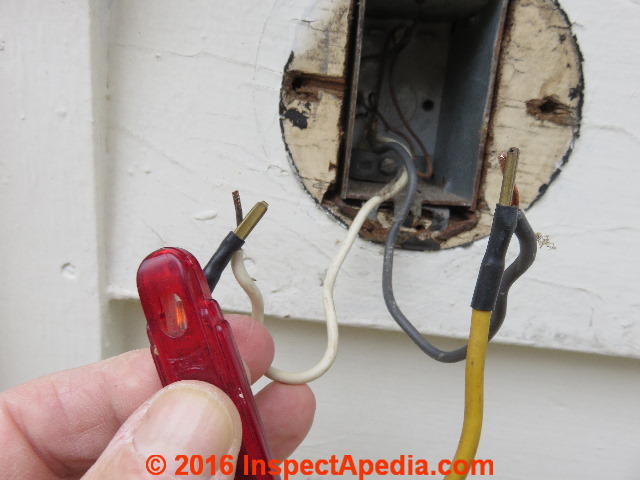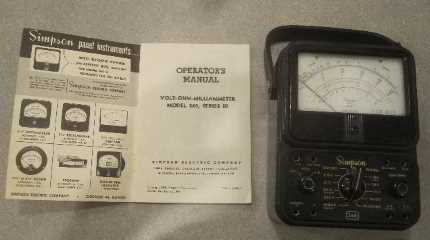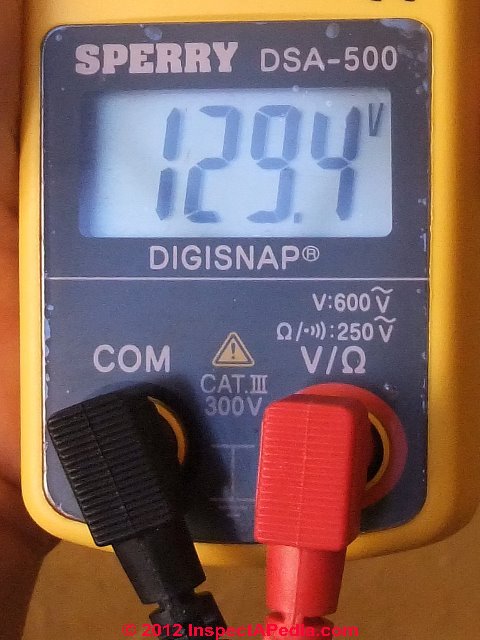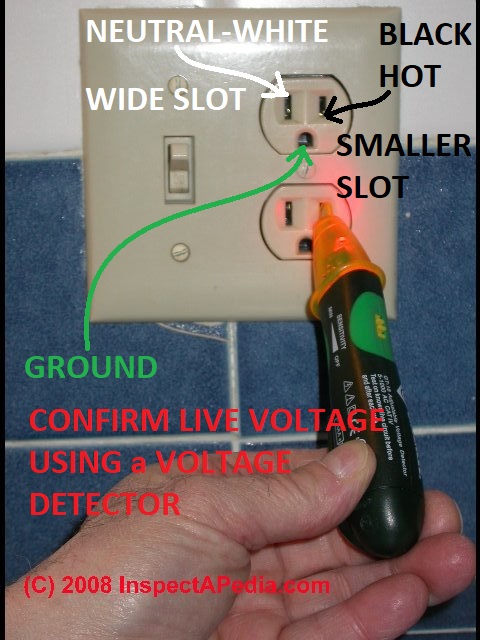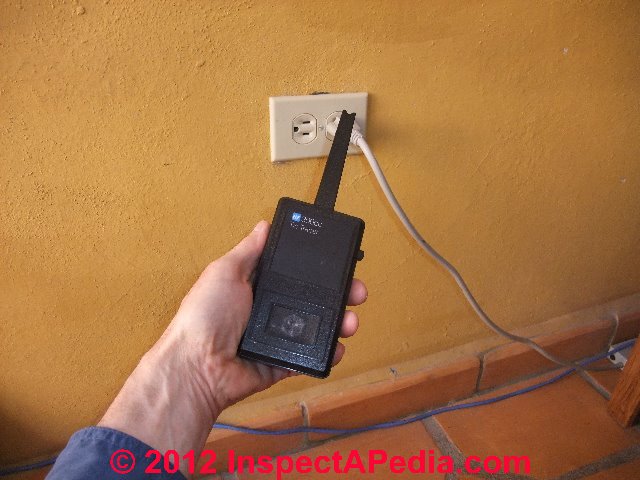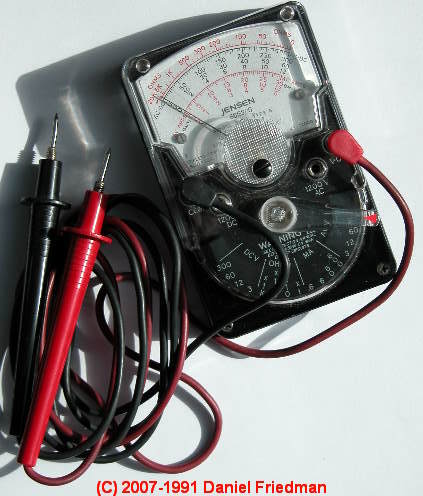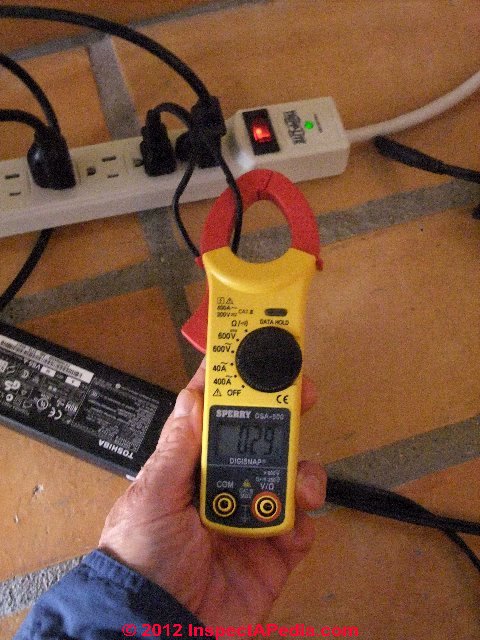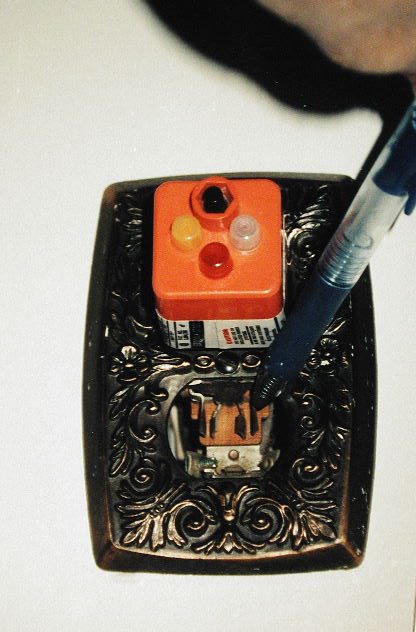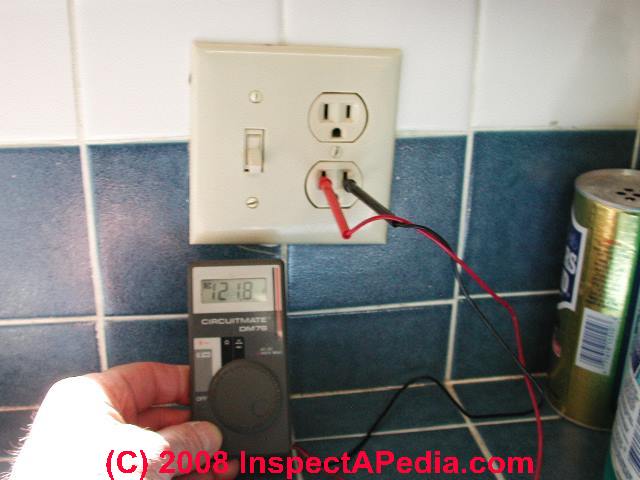 Devices Used to Detect or Measure Voltage
Devices Used to Detect or Measure Voltage
Choices of Devices used to Detect or Measure Electrical Voltage at / in a Building
- POST a QUESTION or COMMENT about how to detect or measure voltage at electrical wiring or electrical devices.
Electrical voltage detection and measurement methods & tools:
This article describes the range of equipment or tool choices used to detect or measure voltage and other electrical values.
We describe the use of digital multimeters(DMMs), Volt-ohm meters (VOMs), neon testers and other types of voltage detectors used to check for the presence of voltage, to check for live electrical circuits and to measure electrical system voltage and amperage levels.
InspectAPedia tolerates no conflicts of interest. We have no relationship with advertisers, products, or services discussed at this website.
- Daniel Friedman, Publisher/Editor/Author - See WHO ARE WE?
Voltage Test Equipment Types: How to Determine Electrical Voltage (240V/120V) using a neon tester, a VOM, DMM, Volt Meter, or Voltage Detector pen
 Instruments as simple as the neon-tester shown here or a digital multimeter (DMM), or an analog volt meter (volt-ohm meter or VOM) such as
those made by Triplett, Fluke, Simpson and Sperry can be used to measure the voltage level between the two power
feed lines to confirm the presence of 240 Volt service. (Some versions of this equipment can also be configured to measure amperage or amps).
Instruments as simple as the neon-tester shown here or a digital multimeter (DMM), or an analog volt meter (volt-ohm meter or VOM) such as
those made by Triplett, Fluke, Simpson and Sperry can be used to measure the voltage level between the two power
feed lines to confirm the presence of 240 Volt service. (Some versions of this equipment can also be configured to measure amperage or amps).
Using a DMM, A VOM -analog volt meter, or a neon tester, voltage between the two apparently "hot" wires in the panel will confirm 240-volt service. If only one cable is "hot" (testing cable to ground) it is a 120 V system. If both cables are "hot" to ground but there is no voltage between them it is a 120V system which has been "split" to look like 240V but it is not 240V.
What's the difference between using a neon tester (shown at left) and using a VOM or digital voltage meter?
A neon tester, containing just a light bulb, simply indicates the presence of live voltage but not the actual voltage level. A volt meter is required to test for other voltage levels or to determine the actual voltage level as well as to check for voltage that may vary over time.
Watch out: this is not a reliable nor a complete electrical system test. For example, a weakly-grounded wire or electrode may look just fine when tested with a VOM, a DMM, or a neon tester, but when subject to higher current flow the ground may be completely inadequate.
Watch Out: The ASHI Standards of Practice and other home inspection standards for electrical inspections do not require the inspector to insert any instrument into the service panel.
Therefore this testing is optional.
It's also a dangerous procedure that can damage electrical equipment or worse, cause electrical shock, or even death, and should not be undertaken unless the person conducting the examination is trained and competent to avoid electric shock.
A detailed example of safe use of a neon tester to check for voltage is
at REPAIR AUTOMATIC OUTDOOR LIGHT FIXTURE.
If the inspector is not trained for this procedure
s/he should never insert any instrument or tool into electrical equipment.
See SAFETY for ELECTRICAL INSPECTORS at Residential Electric Panels.
Definitions of Common Electrical Test Meter Types
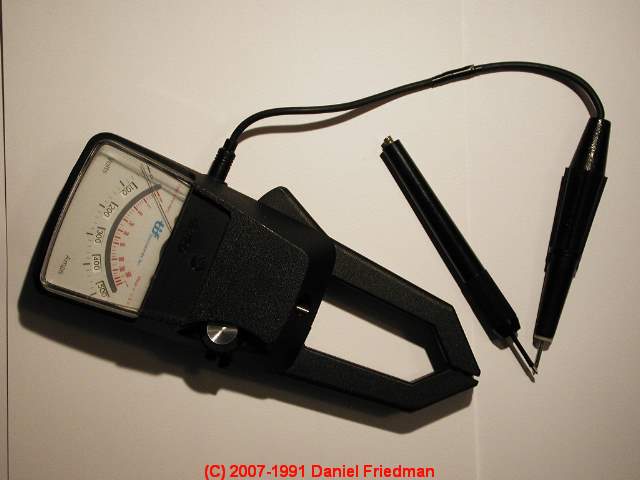
- An ammeter
measures electrical current. Our photo at left shows the author's multi-meter that can measure amps as well as serve ad a VOM - a volt-ohm volt meter.
Details of using an ammeter to measure building, individual circuit, or individual electrical appliance amps are found
at AMPS MEASUREMENT METHODS. - A voltage detector
uses a light, sound, or both to indicate the presence of live electrical voltage - A voltmeter
measures the potential difference (voltage) between two points.
Details of how to use a DMM or VOM to measure voltage are
at VOLTS MEASUREMENT METHODS. - An ohmmeter measures resistance.
An ohm meter measures resistance in a circuit or on a component and is not normally connected to a circuit carrying live voltage. Both DMMs and VOMs are used to measure resistance in ohms. - An analog volt-ohm meter or VOM
a multi-purpose electrical test instrument that can measure AC or DC voltage, resistance (ohms), and depending on the model current (amps). Some VOMs can also measure sound levels (decibels) or other metrics using an appropriate attachment. The display on an analog VOM uses a needle or pointer that rotates over display values in an arc.
You can see an example of a analog display in the VOM shown at above left. That meter includes a clamp-on ammeter for measuring current. Below is a Simpson analog VOM that has been in use since 1958.
See ANALOG VOMs & MULTIMETERS for examples of and information about buying & using VOMs.
- A digital multimeter (DMM)
is a multi-purpose electrical test instrument that can measure AC or DC voltage, resistance (ohms), current (amps) and often other conditions such as sound level (decibels) or temperature by using additional sensors or probes.
The display on a digital multimeter is just that - digital, using an electronically-generated number corresponding to the range at which the DMM is set.
An example of a digital multimeter is shown just belowk the display window of a Sperry DSA-500.
At DMM DIGITAL MULTIMETER HOW TO USE we explain the function and level settings and probe connections needed when using a VOM or DMM to measure voltage (as well as when measuring current or resistance).
Photo above: the Digisnap DMM from Sperry. More photos of this meter in use are below on this page.
In this article we provide photographs and descriptions of each of these types of electrical test instruments.
Photographs & properties of electrical test equipment useful for a building inspector, electrical inspector, contractor, or homeowner
If you're unsure about the definitions of amps, volts, ohms, resistance, watts, etc.
see DEFINITIONS of ELECTRICAL TERMS.
A voltage detector of voltage sensor detects the presence of live AC voltage (some equipment also detects DC voltage), with a sensitivity typically between 5 and 1000 Volts.
I like using this device because it can sense the presence of live electrical devices or wiring without actually touching the electrical device or wire.
Shown here (left) is the Greenlee® GT-16 adjustable voltage detector. Greenlee and other manufacturers recommend that you test the operation of the voltage detector on a known live circuit both before and after using it to test for the presence of electrical voltage at a wire or device.
This device uses an AAA battery and has a sensitivity adjustment (the yellow dial in the center of the green patch on the device).
Some voltage sensors such as the FCB Voltage Pen operate without requiring a battery.
Tic Tracer Tif 300cc voltage detector - properties & special uses: A different sort of voltage sensor detects the presence of live AC voltage is shown at left, the Tif 300cc Tic Tracer.
This was one of the first home inspection tools I purchased and it or its successors are still widely used by electrical inspectors and home inspectors.
Depending on the version, this instrument does not use an LED or neon bulb but emits a buzzing or "ticking" noise at a varying rate depending on how close it is held to a voltage source and also varying by voltage level.
Turning the instrument on gives a slow electronic tic-tic sound at a regular rate. Holding the sensor tip close to an electrical outlet or even along an electrical wire connected to such a receptacle results in an increase in the tic rate of the instrument.
And with even a limited amount of practice you can quickly learn to recognize the much faster tic rate (really a buzz) that the TIF makes when held close to a 240V circuit in comparison with a 120V electrical circuit.
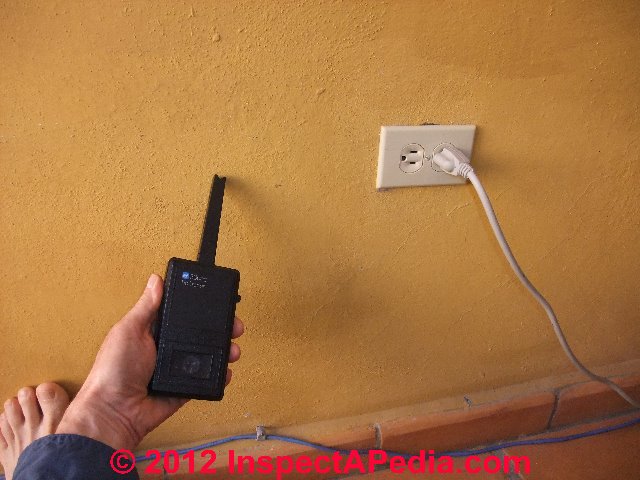
Unlike the elegantly simple neon tester, and more like the Greenlee® GT-16, the TIF Tic Tracer does not need direct contact between sensor pins and live electrical contacts in order to detect the presence of electrical voltage (photo, above left).
But unlike the Greenlee® GT-16 that needs to be very close to an electrical circuit or component in order to indicate the presence of voltage, the TIF Tic Tracer 300cc can sometimes detect the presence of electrical wires behind drywall (depending on the depth of wires inside the wall cavity and other factors) - as we illustrate in our second Tif 300cc photo, shown at left.
Watch out: the sensor tip of the Tif Tic Tracer is also sensitive to static electricity and possibly to vibration.
If you rapidly swipe the sensor tip along the surface of a wall the instrument will sound wildly - an effect we once used to castigate an aggressive real estate agent.

- A multimeter or DMM combines these functions into one piece of equipment and is often called a VOM or volt-ohm meter. Our little VOM/DMM shown at left is being used to check for voltage at an electrical receptacle. If you click and enlarge the photo you can see the meter reading.
- A neon tester simply measures for the presence of live electrical power as we demonstrated above.
- A continuity tester is a simple substitute for a more sophisticated ohm meter, and is used simply to confirm that there is electrical continuity on a circuit, that is,
that it is not interrupted by a switch or open connection.
Some simple ohm-meters or multimeters include a switch position that emits a tone if there is good electrical conductivity (low resistance) between the two points being touched by the probes.
Analog VOMs - Volt-Ohm-Milliameters
A VOM or volt-ohm meter may also be found in an analog form such as our favorite and now a collectors-item little Jensen VOM that we've used for nearly 30 years. Here our photo shows the Jensen analog VOM with its probes attached but not connected to anything.
In more than 40 years of use I needed just ne repair of this instrument - an internal fuse which we couldn't find locally. In analog VOMs such as this unit there is typically a very low-amperage fuse whose function is to protect the meter movement from damage.
This little VOM, ca 1985, is about 1/8 the size of the Simpson 260, ca 1958, described just below.
Simpson produces a wide range of test instruments including analog VOMs that can be used to measure resistance (ohms), direct current, alternating current, and even decibels.
See ANALOG VOMs & MULTIMETERS for examples of VOMs.
Amperage or current measurements using clamp on or snap around digital ammeters, DMMs, & (some) VOMs
At above left we are measuring the current draw in amps for the charging block of a laptop computer. Shown is Sperry's Digisnap DSA-500 snap-around digital multimeter.
Details about using a clamp-on or snap around ammeter are at
Notice that the electrical wire was split so that the clamp-on ammeter's jaws surround just one of the two electrical wires. The transformer jaws or "clamp" must surround just one of the two 120V wires supplying the electrical device.
Also notice that we did not disturb nor damage the electrical wire insulation itself - doing so is dangerous and risks equipment damage or dangerous electrical shock as we cite just above.
At the moment of our measurement this electrical device was drawing 0.29A at 120V.
For an accurate calculation of actual energy consumed that includes the effects of AC current and power factors,
see DEFINITION of Power Factor, Real Power.
What about using a simple receptacle tester to measure voltage?
Receptacle testers are used by most home inspectors to check for proper wiring at electrical receptacles as well as to check the function of GFCI's.
For testing AFCI's the only reliable test currently available is the device's own test button. We provide details about using receptacle testers
at ELECTRICAL TOOLS Every Homeowner Should Have
Where to Buy a DMM or VOM
List of Electrical Test Instruments, VOMs, DMMs, Voltage Detectors: Manufacturers & Sources
- Actron DMMs & VOMs, Website: http://www.actron.com/
- ALL-SUN/e-sun ; Model Number: EM3212 Pen type mini portable Voltmeter Ohmmeter Ammeter pocket-size digital multimeters - [Check for suitable precision and accuracy in low range amps measurement applications]
- Amptec 720A Micro-Ohmmeter, Amptec Research Co., 14101 Hwy 290 W., Bldg 2000A, Austin TX 78737 USA, Tel: 1-800-350-5105, The AMPTEC 720A Micro-Ohmmeter has the identical ranges, resolution and it offers slightly better accuracy than the obsolete Keithley 580 Ohmmeter.
- Digisnap DSA-500 snap-around digital multimeter, A.W. Sperry Instruments Inc., 2150 Joshua's Path, Suite 202, Hauppage NY 11788, Tel: 800-645-5398, Email: cat@awsperry.com, Website: www.awsperry.com
- Equus Multimeters by Innova, Equus Products, Inc., 17352 Von Karman Ave., Irvine, CA 92614, U.S.A., Tel: 714-241-6800, Website: http://www.equus.com/
- ExTech DMMs & VOMs, ExTech Corp. a FLIR company, Extech Instruments Corporation, 9 Townsend West, Nashua, NH 03063, U.S.A., Email: support@extech.com, Tel: 877-239-8324 Option 3, Website: http://www.extech.com
- Fluke Corporation, 6920 Seaway Blvd, Everett, WA 98203, USA, PO Box 9090 Everett, Washington 98206, Tel: +1(425) 347-6100, Technical support: 1(800) 44-FLUKE (1(800) 443-5853), Website: www.fluke.com,
Fluke Europe B.V, PO Box 1186 Eindhoven, The Netherlands, Tel: +31 (0)40 2 675 200 +31 (0)40 2 675 222, Website: www.fluke.eu- Fluke India: TTL India Pvt. Ltd. (A Fluke Company), Deodhar Center, 424, Marol Maroshi Road, Andheri (E), Mumbai, 400076, Tel: 1 800 209 9110, Email: info.india@fluke.com, Website: http://www.fluke.com/fluke/inen/products/Digital-Multimeters.htm
- Digital 287/289 Digital Multimeter, Users Manual, retrieved 9/5/21, original source: http://assets.fluke.com/manuals/287_289_umeng0200.pdf, [copy on file as Fluke_287_289_umeng0200.pdf]
- Gowe® Multifunctional Portable Mini Oscilloscope+multimeter (Voltmeter Ohmmeter Capacitance Tester) Handheld Digital Scopemeter - [Check for suitable precision and accuracy in low range amps measurement applications]
- Jensen VOMs, no longer available
- Mastech VOMs and DMMs (made in China), Shanghai Hihua V&A Instrument Company, 881 Ye Cheng Road Jia Ding District, Shanghai 201821, China, Email: mastech@vip.sina.com, Tel: +86 21 69523164 +86 21 69523225, Website: http://www.mastech.com.cn/
- Seaward U.K., Bracken Hill, Southwest Industrial Estate, Peterlee, County Durham, SR8 2SW, United Kingdom, Tel: 44 0 191 586 3511, Fax: 044-191-586-0277, Email: enquiry@seaward.co.uk , Website: www.seaward.co.uk
Seaward Group USA 6304 Benjamin Road, Suite 506, Tampa FL 33634, Tel: 001 (813) 886 2775, Email: sales@seaward-groupusa.com , Website: http://www.seaward-groupusa.com, - Simpson Electric, P.O. Box 99, 520 Simpson Avenue, Lac du Flambeau, WI 54538-0099 Tel: 715-588-3311, customer service: 715-588-3947, Email: support@simpsonelectric.com, Website: www.simpsonelectric.com/
- Simpson 260® Series 6XLM Volt-Ohm-Milliammeter Instruction Manual, retrieved 9/5/2012, original source: http://www.simpsonelectric.com/uploads/File/datasheets/260-6xlm.pdf, [copy on file as Simpson_260-6xlm.pdf]
- Speco Technologies, 200 New Highway, Amityville NY 11701 Tel: 1-800-645-5516 - Analog VOMs
- T.D. Instruments Corporation, The MINI AMMETER used for adjusting thermostats to work precisely (shown at the top of this page) was produced by and may still be available from T.D. Instruments Corporation, 180 Charlotte St., Rochester, NY 14067 - 716-232-4208. We used model T.D. 2, which operates between 0 and 1.2 Amps A.C. If this instrument is not available look for an ammeter capable of operating with precision in the same very low-end range of current draw from 0 - 2 Amps.
- tif 300cc Tic Tracer voltage detector, Tif Instruments Inc., 9101 NW 7th Avenue, Miami, Florida 33150
- Greenlee® GT-16 adjustable voltage detector, Greenlee Textron Inc., Website: greenlee.com, Tel: 800-435-0786, Email: techsupport@greenlee.textron.com
...
Continue reading at VOLTS MEASUREMENT METHODS or select a topic from the closely-related articles below, or see the complete ARTICLE INDEX.
Or see these
Recommended Articles
Suggested citation for this web page
VOLTS / AMPS MEASUREMENT EQUIP at InspectApedia.com - online encyclopedia of building & environmental inspection, testing, diagnosis, repair, & problem prevention advice.
Or see this
INDEX to RELATED ARTICLES: ARTICLE INDEX to ELECTRICAL INSPECTION & TESTING
Or use the SEARCH BOX found below to Ask a Question or Search InspectApedia
Ask a Question or Search InspectApedia
Try the search box just below, or if you prefer, post a question or comment in the Comments box below and we will respond promptly.
Search the InspectApedia website
Note: appearance of your Comment below may be delayed: if your comment contains an image, photograph, web link, or text that looks to the software as if it might be a web link, your posting will appear after it has been approved by a moderator. Apologies for the delay.
Only one image can be added per comment but you can post as many comments, and therefore images, as you like.
You will not receive a notification when a response to your question has been posted.
Please bookmark this page to make it easy for you to check back for our response.
Our Comment Box is provided by Countable Web Productions countable.ca
Citations & References
In addition to any citations in the article above, a full list is available on request.
- The Original Authors: Alan Carson is an ASHI Member, national home inspection educator, author and building failures researcher in Toronto, Ontario. Daniel Friedman, an original author of this article and the editor and producer of InspectAPedia where this article now appears is an ASHI Member, first ASHI Technical Committee chairman, editor and publisher of the ASHI Technical Journal, licensed home inspector, educator, and building failures researcher in Poughkeepsie, NY. Robert Klewitz is a licensed professional engineer, a professional home inspector, an ASHI Member, and has served on the ASHI Technical Committee as well as in other ASHI activities. His practice is in Issaquah, WA.
- ASHI Technical Journal, Vol. 2. No. 1, January 1992, "Determining Service Ampacity," Dan Friedman and Alan Carson, and the
- ASHI Technical Journal, Vol. 3. No. 1, Spring, 1993, "Determining Service Ampacity - Another Consideration," Robert L. Klewitz, P.E., with subsequent updates and additions to the original text ongoing to 2/19/2006. Reprints of the originals and reprints of the Journal are available from ASHI, the American Society of Home Inspectors www.ashi.com.
- [4] Digisnap DSA-500 snap-around digital multimeter, A.W. Sperry Instruments Inc., 2150 Joshua's Path, Suite 202, Hauppage NY 11788, Tel: 800-645-5398, Email: cat@awsperry.com, Website: www.awsperry.com
- [5] Fluke Corporation, 6920 Seaway Blvd, Everett, WA 98203, USA, PO Box 9090 Everett, Washington 98206, Tel: +1(425) 347-6100, Technical support: 1(800) 44-FLUKE (1(800) 443-5853), Website: www.fluke.com,
Fluke Europe B.V, PO Box 1186 Eindhoven, The Netherlands, Tel: +31 (0)40 2 675 200 +31 (0)40 2 675 222, Website: www.fluke.eu - Digital 287/289 Digital Multimeter, Users Manual, retrieved 9/5/21, original source: http://assets.fluke.com/manuals/287_289_umeng0200.pdf, [copy on file as Fluke_287_289_umeng0200.pdf]
- [6] Simpson Electric, P.O. Box 99, 520 Simpson Avenue, Lac du Flambeau, WI 54538-0099 Tel: 715-588-3311, customer service: 715-588-3947, Email: support@simpsonelectric.com, Website: www.simpsonelectric.com/
- Simpson 260® Series 6XLM Volt-Ohm-Milliammeter Instruction Manual, retrieved 9/5/2012, original source: http://www.simpsonelectric.com/uploads/File/datasheets/260-6xlm.pdf, [copy on file as Simpson_260-6xlm.pdf]
- [7] tif 300cc Tic Tracer voltage detector, Tif Instruments Inc., 9101 NW 7th Avenue, Miami, Florida 33150
- [8] Greenlee® GT-16 adjustable voltage detector, Greenlee Textron Inc., Website: greenlee.com, Tel: 800-435-0786 , Email: echsupport@greenlee.textron.com,
- [9] Jensen VOMs, no longer available
- [10] Mastech VOMs and DMMs (made in China), Shanghai Hihua V&A Instrument Company, 881 Ye Cheng Road Jia Ding District, Shanghai 201821, China, Email: mastech@vip.sina.com, Tel: +86 21 69523164 +86 21 69523225, Website: http://www.mastech.com.cn/
- [11] Equus Multimeters by Innova, Equus Products, Inc., 17352 Von Karman Ave., Irvine, CA 92614, U.S.A., Tel: 714-241-6800, Website: http://www.equus.com/
- [12] Actron DMMs & VOMs, Website: http://www.actron.com/
- [13] ExTech DMMs & VOMs, ExTech Corp. a FLIR company, Extech Instruments Corporation, 9 Townsend West, Nashua, NH 03063, U.S.A., Email: support@extech.com, Tel: 877-239-8324 Option 3, Website: http://www.extech.com
- Mark Cramer Inspection Services Mark Cramer, Tampa Florida, Mr. Cramer is a past president of ASHI, the American Society of Home Inspectors and is a Florida home inspector and home inspection educator. Contact Mark Cramer at: 727-595-4211 mark@BestTampaInspector.com 11/06
- Douglas Hansen, Robert Stead. Mark Cramer. Photographs: Daniel Friedman.
- N. Srinivasan, MSEE, is a senior member of IEEE with 30 years experience in the electrical industry. Mr. Srinivasan is in Vienna VA.
- Louis P. Babin generously contributed technical editing about the effects of doubling ampacity in an electrical circuit (September 2007)
- Paul Galow [Website galowconsulting.com ] - technical consultant on networking, LAN design, applications support. Galow Consulting Services [Website galowconsulting.com ] , 914-204-1749, email: paulgalow@galowconsulting.com
- "Electrical System Inspection Basics," Richard C. Wolcott, ASHI 8th Annual Education Conference, Boston 1985.
- "Simplified Electrical Wiring," Sears, Roebuck and Co., 15705 (F5428) Rev. 4-77 1977 [Lots of sketches of older-type service panels.]
- "How to plan and install electric wiring for homes, farms, garages, shops," Montgomery Ward Co., 83-850.
- "Simplified Electrical Wiring," Sears, Roebuck and Co., 15705 (F5428) Rev. 4-77 1977 [Lots of sketches of older-type service panels.]
- "Home Wiring Inspection," Roswell W. Ard, Rodale's New Shelter, July/August, 1985 p. 35-40.
- "Evaluating Wiring in Older Minnesota Homes," Agricultural Extension Service, University of Minnesota, St. Paul, Minnesota 55108.
- "Electrical Systems," A Training Manual for Home Inspectors, Alfred L. Alk, American Society of Home Inspectors (ASHI), 1987, available from ASHI. [DF NOTE: I do NOT recommend this obsolete publication, though it was cited in the original Journal article as it contains unsafe inaccuracies]
- In addition to citations & references found in this article, see the research citations given at the end of the related articles found at our suggested
CONTINUE READING or RECOMMENDED ARTICLES.
- Carson, Dunlop & Associates Ltd., 120 Carlton Street Suite 407, Toronto ON M5A 4K2. Tel: (416) 964-9415 1-800-268-7070 Email: info@carsondunlop.com. Alan Carson is a past president of ASHI, the American Society of Home Inspectors.
Thanks to Alan Carson and Bob Dunlop, for permission for InspectAPedia to use text excerpts from The HOME REFERENCE BOOK - the Encyclopedia of Homes and to use illustrations from The ILLUSTRATED HOME .
Carson Dunlop Associates provides extensive home inspection education and report writing material. In gratitude we provide links to tsome Carson Dunlop Associates products and services.


